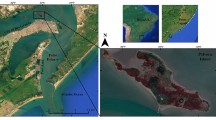Abstract
Nitrate reductase activity and the concentrations of selenite and selenate were monitored for six months at the mouth of Chesapeake Bay (USA). A positive correlation was found between nitrate reductase activity and the concentration of selenite, suggesting that selenite may be formed in coastal waters and nitrate reductase may be involved in the process.
Similar content being viewed by others
References
Anderson, S.M. and O.A. Roels (1981): Effects of light intensity on nitrate and nitrite uptake and excretion byChaetoceros curvisetus. Mar. Biol.,62, 257–261.
Cutter, G.A. and K.W. Bruland (1984): The marine biogeochemistry of selenium: a reevaluation. Limnol. Oceanogr.,29, 1179–1192.
Eppley, R.E., J.L. Coatsworth and L. Solorzano (1969): Studies of nitrate reductase in marine phytoplankton. Limnol. Oceanogr.,14, 194–205.
Harrison, W.G. (1973): Nitrate reductase activity during a dinoflagellate bloom. Limnol. Oceanogr.,18, 457–465.
Holmes, R.W., P.M. Williams and R.W. Eppley (1967): Red water in La Jolla Bay, 1964–1966. Limnol. Oceanogr.,12, 503–512.
Kristiansen, S. (1983): The temperature optimum of the nitrate reductase assay for marine phyto-plankton. Limnol. Oceanogr.,28, 776–780.
Kristiansen, S. (1987): Nitrate reductase activity in phytoplankton from the Oslofjord, Norway. J. Plank. Res.,9, 739–748.
Measures, C.I. and J.D. Burton (1980): The vertical distribution and oxidation states of dissolved selenium in the northeast Atlantic Ocean and their relationship to biological processes. Earth. Planet. Sci. Letts,46, 385–396.
Measures, C.I., R.E. McDuff and J.M. Edmond (1980): Selenium redox chemistry at GEOSECS I reoccupation. Earth. Planet. Sci. Letts,49, 102–108.
Measures, C.I., B.C. Grant, B.J. Mangum and J.M. Edmond (1983): The relationship of the distribution of dissolved selenium IV and VI in three oceans to physical and biological processes. p. 78–83.In: Trace Metals in Sea Water, ed. by C.S. Wong, E. Boyle, K.W. Bruland, J.D. Burton and E.D. Goldberg, Plenum Press, New York.
Measures, C.I., B. Grant, K. Khadem, D.S. Lee and J.M. Edmond (1984): Distribution of Be, Al, Se and Bi in the surface waters of the western North Atlantic and Caribbean. Earth. Planet. Sci. Letts,71, 1–12.
Raimbault, P. (1986): Effect of temperature on nitrite excretion by three marine diatoms during nitrate uptake. Mar. Biol.,92, 149–155.
Sillen, L.G. (1961): The physical chemistry of sea water. p. 549–581.In: Oceanography, ed. by M. Sears, American Association of the Advancement of Science, Washington, D.C.
Strickland, J.D.H. and T.R. Parsons (1972): A Practical Handbook of Seawater Analysis, 2nd ed. Fish. Res. Board Canada, Ottawa, 310 pp.
Stumm, W. and J.J. Morgan (1981): Aquatic Chemistry, 2nd ed. John Wiley & Sons, New York, 780 pp.
Sugimura, Y., Y. Suzuki and Y. Miyake (1976): The content of selenium and its chemical form in seawater. J. Oceanogr. Soc. Japan,32, 235–241.
Suzuki, Y., Y. Sugimura and Y. Miyake (1980): The content of selenium in sea water in the western North Pacific and its marginal seas. p. 396–414.In: The Kuroshio IV, Saikon Publishing, Tokyo.
Takayanagi, K. and G.T.F. Wong (1983): Fluorimetric determination of selenium (IV) and total selenium in natural waters. Anal. Chim. Acta,148, 263–269.
Takayanagi, K. and G.T.F. Wong (1985): Dissolved inorganic and organic selenium in the Orca Basin. Geochim. Cosmochim. Acta,49, 539–546.
Tsunogai, S. and T. Sase (1969): Formation of iodide-iodine in the ocean. Deep-Sea Res.,16, 489–496.
van der Sloot, H.A., D. Hoede, J. Wijkstra, J.C. Duinker and R.F. Nolting (1985): Anionic species of V, As, Se, Mo, Sb, Te and W in the Scheldt and Rhine Estuaries and the Southern Bight (North Sea). Estuarine Coast. Shelf Sci.,21, 633–651.
Yentsch, C.S. and D.W. Menzel (1963): A method for the determination of phytoplankton chlorophyll and phaeophytin by fluorescence. Deep-Sea Res.,10, 221–231.
Author information
Authors and Affiliations
Rights and permissions
About this article
Cite this article
Takayanagi, K., Wong, G.T.F. & Filardo, M.J. Nitrate reductase activity and the speciation of selenium at the mouth of Chesapeake bay. Journal of the Oceanographical Society of Japan 45, 129–133 (1989). https://doi.org/10.1007/BF02108886
Received:
Revised:
Accepted:
Issue Date:
DOI: https://doi.org/10.1007/BF02108886




